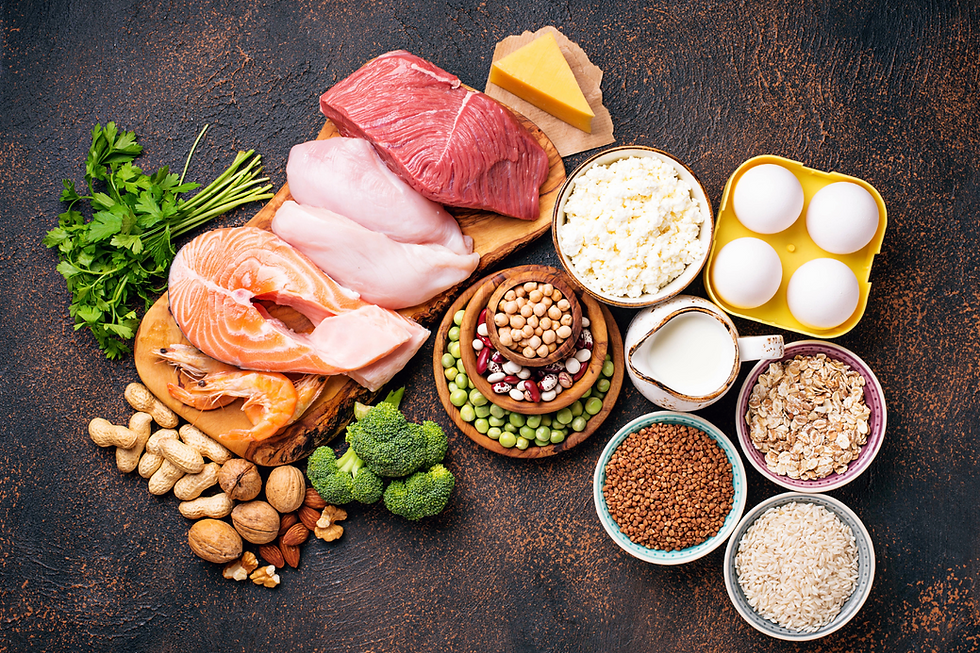Menopause and Protein: How Much, Sources and Considerations
- Brandi Smith
- Dec 5, 2024
- 3 min read
Updated: Feb 4
As we age, we need more protein, not less.

For women who are in perimenopause, menopause or postmenopause and
who want to stay active, healthy, and strong, it's recommend that you eat 1.4–2.2 grams of protein per kilogram of bodyweight per day.
That’s an average of about 0.8 grams per pound of bodyweight a day. So if you weigh 150 pounds, we recommend shooting for 120 grams of protein per day.
But let’s keep it simple.
A standard serving of a high-protein food would be about the size and thickness of the palm of your hand. That’s about 20–30 grams of protein.
Most women will end up needing the equivalent of 3–6 palm-size servings of high-protein foods per day, or roughly 1–2 servings per meal.
What Foods are High in Protein?
It’s important to note, some foods are high in protein, while others have moderate protein. Moderate-protein foods tend to be higher in other macronutrients like carbs or fat, but can still contribute to daily protein intake.
High protein foods include:
Lean beef
Lean pork
Lean game meats (e.g., venison, rabbit)
Lamb
Fish
Shellfish (e.g., shrimp, scallops)
Poultry (e.g., chicken, turkey, duck)
Eggs and egg whites
Dairy products
Cottage cheese
Greek yogurt, plain
Moderate-protein foods include:
Dairy
These foods are lower in protein, but still contribute to the daily total.
Cheese (typically higher in fat)
Milk
Plain yogurt
Legumes/beans
These tend to be high in carbs and are normally categorized as a carb source.
Chickpeas, black beans, kidney beans, lentils, etc.
Nuts, seeds, nut and legume butters
These tend to be high in fat and are normally categorized as a fat source.
Walnuts, almonds, pecans, hemp seeds, pumpkin seeds, etc.
What About Protein Powder?
Protein powders can help boost your daily protein intake, and often contain a number of other important nutrients. Read labels carefully when choosing a protein powder or recommending one to your client, and look for one with minimal ingredients that’s been tested for quality by a third-party lab. Websites such as ConsumerLab.com and Labdoor.com have test results.
Animal-Sourced Options:
Whey
Casein
Egg/egg white
Beef isolate
Plant-Based Options:
Hemp protein
Rice protein
Pea protein
Pumpkin seed protein
Vegan protein blends
Plant-Based Protein Options
If you prefer a fully plant-based diet, be aware that plant foods don’t always have a full complement of amino acids, so try to eat several different sources of protein throughout the day, such as:
Beans and legumes—or foods derived from them, such as:
Tofu
Tempeh
Bean pasta
Higher-protein whole grains, such as:
Quinoa
Amaranth
Steel-cut or whole oats
Teff
Buckwheat
Brown or wild rice
Many people assume that nuts, seeds, and nut/seed butters are good sources of protein. In fact, these are mainly fat sources. They’re nutritious and delicious, but check the labels (or look up the nutritional information) to see how much protein each choice includes.
A plant-based protein powder can be a handy and healthy option, especially if you also add fruits and vegetables into a protein smoothie.
Additional Considerations
Here are a few more things to keep in mind when adding more protein to your diet:
Protein-rich foods can be higher or lower in fat. Take this into consideration when planning menus—for instance, if your meal already includes one or more fat sources, you might choose to go with a leaner meat.
In general, we encourage clients to focus more on lean proteins, like poultry and fish, and get a moderate intake of protein from meats high in saturated fats, such as bacon, sausage, fatty beef, lamb, and full-fat cheese.
Try to eat as diverse a menu as possible, including plant-based sources, to get a boost of vitamins, minerals, antioxidants, and heart-healthy fats.
When possible, choose protein sources from minimally processed foods. (Think: pork tenderloin vs. hot dogs.)
Above all, it’s most important to aim for changes that are realistic and sustainable. Start with adding one serving of protein to one meal or snack a day, until you’re getting the recommended 3–6 palm-size servings per day.




Comentarios